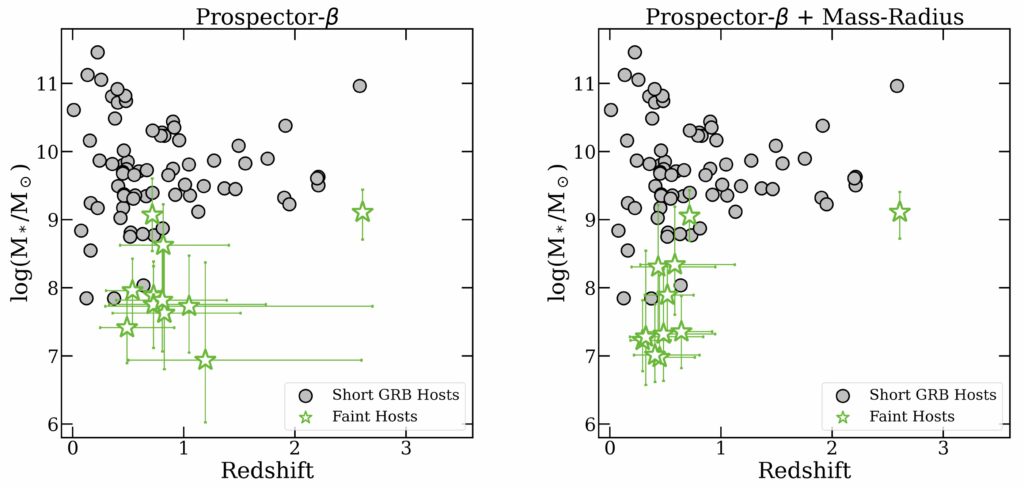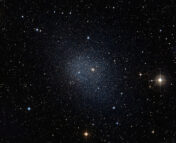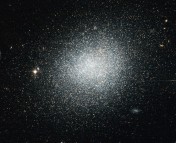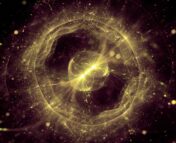Title: A Population of Short-duration Gamma-ray Bursts with Dwarf Host Galaxies
Authors: Anya E. Nugent, Wen-fai Fong, Cristian Castrejon, Joel Leja, Michael Zevin, Alexander P. Ji
First Author’s Institution: Center for Interdisciplinary Exploration and Research in Astrophysics (CIERA) and Department of Physics and Astronomy, Northwestern University
Status: Submitted to ApJ [open access]
Forming the Heaviest Elements
Understanding the origin of the elements is one of the major goals of astronomy research. In recent years, we’ve taken leaps and bounds in this endeavor, thanks in part to the discovery of a neutron star merger in 2017. Neutron stars (NSs) are the dense remnants of massive stars, after they have died in a spectacular explosion. These cosmic beasts are full of neutrons and primarily held together by neutron degeneracy pressure, which is the pressure exerted by neutrons packed so closely together. Neutrons are crucial for forming the heavier elements through a process called the r-process, where neutrons are “rapidly” captured by atomic nuclei to form heavier elements. A natural place for this process to occur then is when two NSs collide, as was seen in both gravitational waves and gamma rays in an event we call GW170817.
GW170817 was an astounding event, and crucially it helped astronomers link the origin of short gamma ray bursts (sGRBs) to the merging of NSs. Gamma ray bursts (GRBs) are short bursts of gamma ray emission that come in 2 different flavors. Long GRBs, which constitute ~70% of all GRBs, typically last longer than 2 seconds and are thought to be related to the formation of jets during the death of some massive stars. On the other hand, short GRBs typically last shorter than 2 seconds and were long thought to be associated with NS mergers, even before the confirmation with GW170817. However, GW170817 didn’t solve all cosmic mysteries – for example, this event was found in an old, passive galaxy, but there are other places in the universe where significant r-process elements are observed, like in dwarf galaxies. The authors of today’s paper set out to understand whether sGRBs can be associated with dwarf galaxies and where NS mergers drive the r-process in these systems.
A Tricky Task – Investigating the Faintest Galaxies
Previous studies of the galaxies hosting sGRBs were not able to study the faintest galaxies because the observational data is so limited. One of the things that is hardest to disentangle is whether these faint galaxies are intrinsically faint (like dwarf galaxies with little stellar mass) or are normal galaxies that are just very far away. With the 11 faintest sGRB host galaxies, today’s authors use new techniques to tackle this problem.
To disentangle how far the host galaxies are (parameterized as redshift) from how massive they are (parameterized by stellar mass, i.e. the total mass of all of the stars in that galaxy), the authors fit data from the Hubble Space Telescope, VLT, and Spitzer with new sophisticated models. They use two new techniques that are specifically designed to handle very limited and noisy data sets. The first new technique is related to the Bayesian analysis they perform – they use informed priors from both theory and observations, which essentially better constrains their results to reasonable physical values. The second novel technique is to include information on the size of the galaxy in their modeling. Galaxies have been shown to follow a relationship between their mass and size, so the authors found that if you include the galaxy’s size information you can get better constraints on the stellar mass and redshift than just using the flux alone!
Short Gamma Ray Bursts Occur in Dwarf Galaxies
Together, these two techniques show that almost all of the faintest sGRB host galaxies are dwarf galaxies (with M* < 109 M☉). Figure 1 shows the stellar mass versus redshift for the faint host studied in this work in green. The left panel shows the results without including the size information. When the size information is included (right panel), the results are consistent and have much less uncertainty. When included with all sGRB hosts, this sample indicates that at least ~13.5% of all sGRBs occur in dwarf galaxies!


Finally, the authors also looked at whether these sGRBs were unique compared to the rest of the sample. There is no evidence for any differences in their afterglow properties, which occur when the jet interacts with the surrounding medium. However, they do find that the sGRBs in these dwarf galaxies occur at smaller offsets from their host galaxies compared to the total population (see Figure 2). This could be due to smaller “kicks” – how fast the resulting compact object is sent flying in the explosion that forms it – than previously expected, which keep the resulting binary and r-process elements within the dwarf galaxy. This is the first piece of evidence that NS mergers can occur within dwarf galaxies and enrich their host galaxy with strong r-process elements, aligning well with our current observations of r-process-enriched dwarf galaxies!
Astrobite edited by Maryum Sayeed
Featured image credit: Adapted from ESA/Hubble & NASA and Wikimedia Commons/J.J.




